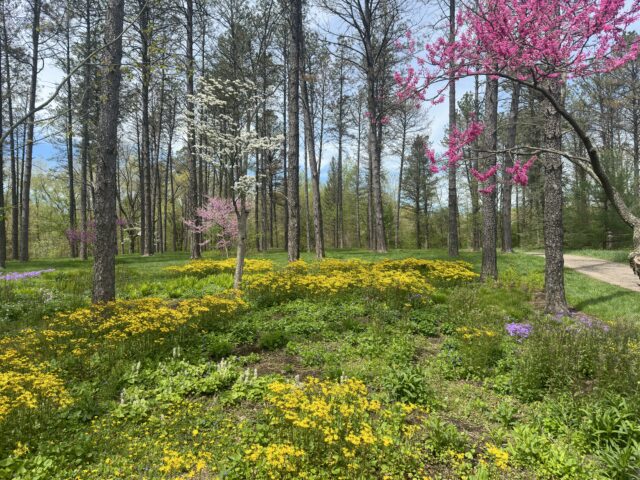
Much of the research we have historically done at the HF&G’s David G. Leach Research Station is directly focused on new plant development. We are trying to breed the next generation of rhododendrons for the gardening public. The scientific, horticultural, and business aspects of plant introduction could be written about ad nauseam, but today, I would like to discuss something at the intersection of all three – naming.
Every plant needs a name to be sold. How else are we going to know what we are buying? But what is in a name? And, is that really what your plant is named?
Name selection for cultivated plants is guided by the International Code of Nomenclature for Cultivated Plants, a 150+ page book of rules. Selections of cultivated plants are usually given cultivar names, “cultivar” presumed to be a mash-up of “cultivated” and “variety” and coined by Liberty Hyde Bailey. A cultivar can be a single clone or an assemblage of plants with shared traits. However, these plants must be distinct, uniform, and stable to gain cultivar status. Cultivars are written in single quotes, e.g. Hydrangea paniculata ‘Limelight’, the Limelight hydrangea.
Non-botanists use the words cultivar and variety synonymously, but there is some nuance behind those words because a botanical variety is different from a cultivar/variety. As an example, Asclepias tuberosa ‘Hello Yellow’ is a cultivar/variety of butterfly weed selected for its yellow flowers. A botanical variety would be Asclepias tuberosa var. rolfsii, which is a naturally occurring type of butterfly weed that grows throughout the longleaf pine forests of the Southeast. I prefer to exclusively use “cultivar” to describe cultivated plants for this reason.
In David Leach’s time, most of his rhododendron cultivars were introduced to the nursery industry essentially as free-ware, open-source plants that anyone can propagate and produce. Not a single plant developed by David Leach was patented. But in modern, commercial horticulture, many plants are patented. This allows patent owners to control who can propagate their plants and allows breeders to recoup some of their investment through royalties.
In truth, patenting a plant is not that complicated. First you must identify a plant that is unique from all other plants, and the plant must have first been found in a cultivated setting, not in a natural place like a forest. Then you need to collect data about it. How was it developed or selected? How tall does it get? What colors are the flowers? Are the stems hairy? When does it bloom? In which hardiness zones does it grow? Is it resistant to any pests and diseases? Basically, if you can prove the plant is distinct from any patented plant and pay some fees, you can patent it.
Seven of the first 10 patented plants were roses, including Plant Patent #10, the application for which was filed in March 1931 and protected a climbing rose developed by J. W. Kallay of Painesville, Ohio. After 20 years, a Plant Patent expires and anyone can freely propagate the plant, meaning people have been able to freely propagate Mr. Kallay’s rose for more than 70 years.
Savvy businesspeople in the nursery industry eventually realized that they need a way to protect their patented plants after the 20 years are up, so they turned to trademarks for an added layer of intellectual property protections. Now, if you go to the garden center to purchase a patented plant, you are often purchasing it under a trademarked name rather than its cultivar name. This is where it gets confusing.
Folks have realized that instead of giving their patented plant a fun, attractive cultivar name, like ‘Hello Yellow’ or ‘Limelight’, they can replace that with a seemingly random word or string of letters or numbers. Then they can tack a marketable name on as the trademarked name. Trademarks can be renewed indefinitely, so this effectively provides protections for the plant beyond the 20 years of a patent.
A great example is the original Knock Out® rose. Everyone knows it by the name Knock Out®, but its official cultivar name is ‘Radrazz’. Which would you buy? The patent for ‘Radrazz’ (viewable here: https://patents.google.com/patent/USPP11836P2/en) has expired, so technically anyone can freely propagate it. But no one can sell it under the name Knock Out® except the owner of the trademark.
Similarly, the Endless Summer® hydrangea has the lovely cultivar name of ‘Bailmer’. The patent for this plant expires in October of this year. Once that happens, anyone can propagate and sell ‘Bailmer’, but only the company that owns the Endless Summer® trademark can sell the plant under that name.
People often gripe about this shift from cultivar names to trademark names, if only because sorting through cultivars names and trademarks can be quite confusing. But this system is here to stay. Now, the next time you buy a plant at the garden center, you too can play the name game.

Connor Ryan
Rhododendron Collections Manager











